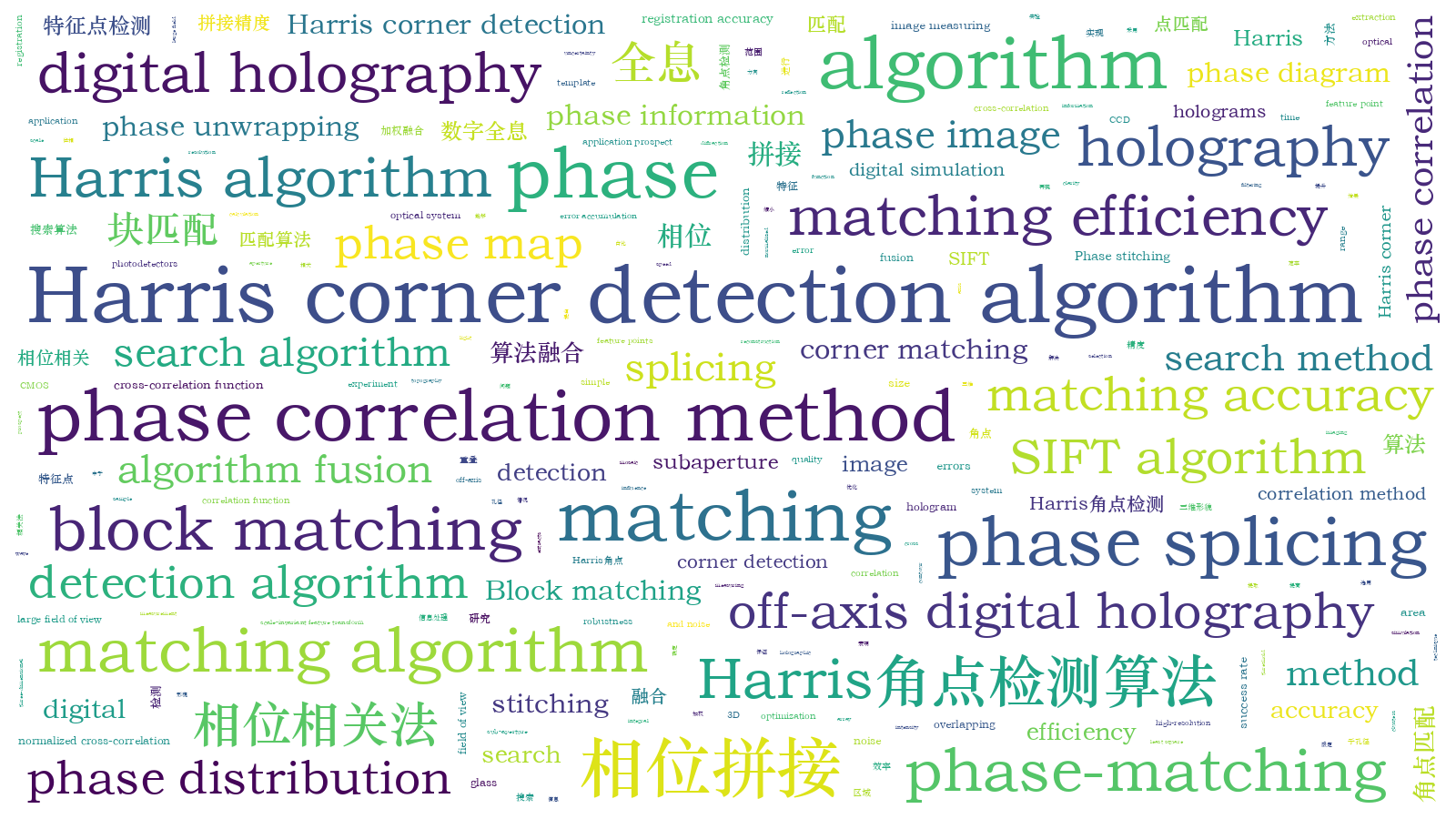全息中基于多算法融合的相位拼接方法研究  下载: 1276次
下载: 1276次
为了解决数字全息中子孔径相位拼接的效率和精度问题,提出了数字全息中基于多算法融合优化的相位拼接方法来实现相位的双方向拼接。首先,在相位拼接中选用相位相关法确定重叠区域,以限定特征点检测和提取范围,从而提升特征点检测的速率和有效特征点检测的占比;然后,对重叠区域进行Harris角点检测和角点匹配,并根据角点匹配点对来缩小块匹配算法的搜索范围;最后,采用全匹配搜索算法对最佳角点匹配点对进行精确匹配,并通过加权融合实现三维形貌的再现相位拼接。实验结果表明,本文算法能够在保证较高的拼接精度的情况下,极大地提高相位拼接的效率。
Objective In digital holography, CCD or CMOS photodetectors are used to record holograms instead of the traditional recording plate in optical holography. The holograms are reproduced through digital simulation. However, array size and the total number of pixels of CCD or CMOS photodetectors restrict the imaging field of view and quality of reconstructed images, limiting the widespread application of digital holography. The main methods to obtain a large field of view images include hologram splicing and phase splicing. The hologram-splicing method is affected by the clarity and noise of the hologram. However, phase stitching provides a method to increase the size of the detection field and improve the quality of three-dimensional (3D) images without increasing the difficulty of the experimental optical system for digital holography. In the field of digital holographic phase stitching, the conventional block-matching algorithm has the disadvantage that the splicing efficiency of block matching is significantly reduced with the increase in the size of the subaperture phase map after the phase image is stitched many times. Block matching is prone to mismatching in similar regions of the phase map. The conventional corner-detection algorithm extracts corners from the entire image with unnecessary corner detection and extraction, leading to excessive registration time consumption and affecting registration accuracy. To solve the problem of efficiency and accuracy of phase stitching of subaperture phase diagram in digital holography, a phase-stitching method based on multi-algorithm fusion optimization is proposed to realize two-way phase stitching in digital holography.
Methods In phase stitching, the phase correlation method is used to determine the overlapping area to limit the detection and extraction range of feature points, thus improving the feature point detection speed and the proportion of effective feature point detection. Harris corner detection is conducted for the overlapping area, and the pseudocorners caused by flat area, noise point, and edges are eliminated according to the phase information of the corner neighborhood. Then, the normalized cross-correlation function is applied for corner matching. Guided complementary matching and voting filtering methods are used to simultaneously eliminate mismatched corner-matching point pairs, and the corresponding best matching point pair is obtained. The search range of the small block matching algorithm is reduced according to the best corner-matching point pair. Finally, the full matching search algorithm is used to accurately match the best corner-matching point pair, and weighted fusion is adopted to realize the reconstruction and phase splicing of 3D topography.
The sub-aperture holograms of four parts of the letter “a” of glass sample plate are collected using the reflection off-axis digital holography experiment system; at least 50% overlapping area should be reserved in the adjacent holograms. Next, the diffraction of a light wave is simulated using a computer. The reconstructed image phase is analyzed using the Fresnel integral formula. The reconstructed image phase distribution is obtained using the least square phase unwrapping. Finally, Harris algorithm, scale-invariant feature transform (SIFT) algorithm, Susan algorithm, full search method, and the proposed algorithm are used to splice the phase map of each subaperture of the letter “a” of the glass template to obtain the intensity map and phase distribution map of the letter “a” of the glass template. The splicing experiment is conducted hierarchically, i.e., the transverse adjacent subaperture phase map (85 pixel×85 pixel) is horizontally spliced, and then the resultant image (115 pixel×85 pixel) is longitudinally spliced. Finally, the overall splicing phase distribution map (115 pixel×125 pixel) is obtained.
Results and Discussions The experimental results showed that there are obvious errors in the phase stitching based on the Harris algorithm; moreover, the phase splicing results based on Susan algorithm are greatly misplaced. However, the results of SIFT algorithm, full search method, and proposed algorithm are better (
Conclusions Phase stitching is an effective method to enlarge the field of view in digital holography. The phase-matching stitching technique of the Harris corner detection algorithm for each subaperture is simple. However, the splicing result has a certain error due to error accumulation. The full search method has the advantages of simple operation and high search accuracy, but it has a large calculation quantity and is prone to mismatching in similar regions. In this study, the phase splicing method based on multi-algorithm fusion optimization in digital holography is proposed by combining the Harris algorithm and full search method points, which can improve the matching efficiency and accuracy. Moreover, it provides full play to the high robustness of the Harris algorithm and does not require objects to have strong edges. It has a wide application prospect in high-resolution mosaic measurement.
谢中思, 郭天太, 刘维, 孔明, 王道档, 郝玲. 全息中基于多算法融合的相位拼接方法研究[J]. 中国激光, 2021, 48(7): 0709001. Zhongsi Xie, Tiantai Guo, Wei Liu, Ming Kong, Daodang Wang, Ling Hao. Phase Splicing Method Based on Multi-Algorithm Fusion in Holography[J]. Chinese Journal of Lasers, 2021, 48(7): 0709001.







